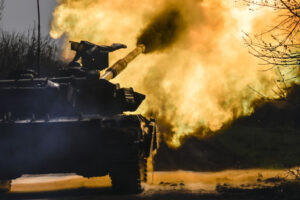In The Convergence of the Twain, Thomas Hardy’s 1912 poem on the loss of the Titanic, the great liner and the iceberg are presented as predestined to meet in their fatal embrace: “Alien they seemed to be/ No mortal eye could see/The intimate welding of their later history/ Or sign that they were bent/By paths coincident/On being anon twin halves of one august event.” Yet each, from their construction in a Belfast shipyard and glacial formation thousands of years ago, were destined to meet in this fateful moment, technology and cold, pitiless nature brought together in consummation of a greater whole.
A similar case can surely be made for war and social media. In an essay written before the Ukraine war, I argued that the conjunction of social media with high quality drone footage from the wars in Syria and Karabakh had created a fusion of online enthusiasts with technology, so that “Drone, camera and social media sharer thus become a single, integrated weapon system, a hybrid semi-autonomous proxy as useful and as cheap to operate as the expendable proxies fighting on the ground”. The Syrian war, like the Spanish Civil War before World War Two, can be considered an armed rehearsal for the Ukraine war, a rough draft of processes and technologies that would later reach their full, terrible potential. And nowhere is this more apparent than in the conjunction of brutal drone footage with social media, and of mass deaths with vigorous online fandoms.
With over 100,000 battlefield dead on each side so far, the Ukraine war is already the bloodiest war in Europe since World War Two. But by one grim milestone, the conflict surely surpasses any war in history: it must hold the record for the greatest number of individual human deaths captured on camera. Through the ubiquity on both sides of cheap consumer drones, used for battlefield reconnaissance and target acquisition, the trenches of eastern Ukraine are surveilled to a hitherto unimaginable extent. And by rigging the drones to drop grenades with pinpoint accuracy — a tactic initially pioneered by Isis in the conflicts in Syria and Iraq — both sides can hunt down, chase and kill individual soldiers with the ease of a video game, sharing the HD video footage for their rival supporters.
The effects on the soldiers themselves are easy to imagine. The knowledge that your every move is being watched by an inescapable whining sky robot waiting to kill you is pure horror. But it is the effect on those sharing the footage that is surely most remarkable. The nature of the clips is unlike anything ever seen from any previous war: hovering a short distance above the victim, the drone’s footage is unbearably intimate: in his final seconds of life, the target looks up at the camera — at you, straight into your eyes. You look down at him: you are the drone. It creates the illusion you have been granted the power of life and death, skimming over the muddy trenches of eastern Ukraine like the angel of death. There is something obscene and terrible in being granted access to these final, miserable moments of human life, a nagging sense that this is something that ought not be seen, let alone enjoyed.
And yet to follow the Ukraine war on a platform like Twitter means your feed is interspersed with the lovingly zoomed-in deaths, shared with crass jokes by Western enthusiasts, of human beings, perhaps unwilling conscripts. Niche online communities like Reddit’s DronedOrc share videos with names such as “Drone drops grenades on orc without pants”, or, “Grenade dropped on orc makes its helmet pop”, for the enjoyment of its subscribers. Scrolling Twitter brings up posts such as “18+ The drone operator drove the orc to suicide,” in which a lone Russian soldier, cornered by a drone, shoots himself. “Last seconds of an orc’s life after catching a grenade from the drone in his rat hole,” gloats another. To fully erode the distinction between themselves and the drone, distant internet consumers of the Ukraine war can even donate 3D-printed fins for their grenades via Twitter, inscribed with their own message, like “Hope this hurts XO.”
Brutal as they are, these videos tell you little about the Ukraine war: one contextless video of a human dying in an anonymous ditch is much the same as another, for all it tells you about the conflict’s progress or outcome. The only difference is for online connoisseurs of individual deaths — praying, pleading, helpless, resigned, crawling away in a trail of blood. This online subculture, a fringe subsection of those following the war, serves no analytical function whatsoever. Instead, it more closely resembles crowds in Roman arenas gawping at the deaths of the condemned: they too, after all, were viewed as criminals, beyond the bounds of human sympathy. The propaganda value of these videos, for the Ukrainian cause, is surely doubtful. For the avoidance of doubt — or rather, to avoid being accused of pro-Russian sympathies by enthusiasts of this strange and awful new content — I want Ukraine to win the war. I understand that to do that, the Ukrainians will have to kill and keep killing thousands of Russian soldiers: that’s what war is. But I don’t particularly need or want to see each individual death. The fact that many apparently do tells you little about Ukraine, but much about human nature and the still-dimly understood nature of social media.
Perhaps, then, conflict and the creation and destruction of enemies is what social media is actually for. In its first heady days at the beginning of the century, the internet’s Arab Spring, the prevailing narrative was that social media was born to bring people together, technology and the human need for connection fusing to progress humanity’s upward arc. Yet anyone who uses social media observes the precise opposite: there is a natural tendency for the medium to produce enemies, often from the slenderest of causes. The most popular content on Twitter by far is that which focuses on the destruction and humiliation of political foes: careers are built from it, fortunes made. There is a curious lacuna in the anthropology of the internet on this easily observable process, one anyone who uses the internet swims in every day without a second thought. The uproar that Musk’s ownership of Twitter has caused among liberals, though never explicitly articulated, is the product of precisely this dynamic. If social media were not primarily a weapon, they would not fear that it is now in the wrong hands, ready to be turned against those accustomed to wielding it.
If war and social media are now inextricably intertwined, fused by the gut satisfaction of watching and sharing clips of your enemies being destroyed, then the peculiarities of America’s own internal conflict are explained. Both sides of the cold civil war hate each other with gut passion, yet open conflict is — except for periods of heightened tension like elections or the BLM protests — unusually rare. In Syria a few years ago, I met an American volunteer who had been driven to the country’s distant battlefield, on the side of the Kurdish YPG, through engagement with America’s own 2016 political ferment. After the Isis war was over, he went back home, taking part in Seattle’s CHAZ experiment, before being jailed for making a social media “call to arms” against Republicans. For him, perhaps the virtual and the real, Syria and America had become too uncomfortably merged: like the Capitol protestors on the other side, who confused Trump’s media-wrought simulacrum of a coup with objective reality, by making the implicit explicit, he moved too soon.
Instead, each side sublimates its hatred for the other in random acts of violence, carried out by unstable proxies, to be pored over, shared and discussed on social media. American conservatives can watch and share footage of IRL proxies such as Kyle Rittenhouse kill and wound their political enemies, and turn him into a hero of their cause, rewarded, as is the nature of American conservatism, with all manner of lucrative sponsorship deals. Had the fatal tussle’s outcome been different, American liberals would no doubt have rewarded their own virtual paladins. In doing so, their desire to take up arms themselves abates: the virtual simulacrum relieves the urge.
Even the most random of America’s deaths by shooting, vastly outpacing Syria’s current death toll, are immediately and obsessively analysed for clues as to which, if any side of America’s civil conflict the killer can be attributed — is he a Hispanic White Nationalist, perhaps, or a radicalised transsexual? The deaths that do not feed this war of interpretation are meaningless, and quickly ignored: it is only the online narratives into which they can be forced that give the killings purpose. Twitter is alive, pulsing with palpable energy, in the immediate aftermath of each atrocity, as each side waits and hopes the blame can be conclusively pinned on their online foes. Like Baudrillard’s Gulf War, America’s civil war is both real and not, a conflict in which, as Baudrillard argued, “the virtual has overtaken the actual” and where “we are already all strategic hostages”, trapped in an internet battlefield, “the screen on which we are virtually bombarded every day”.
Published just before the Ukraine War began, Radical War by the academics Matthew Ford and Andrew Hoskins warned that the fusion of smartphone technology and modern warfare meant that “war is principally about managing the attention of populations and different audiences” in a “media spectacle” where “it is not possible to locate these emergent forms of warfare within existing models of representation and ways of seeing the world”. The smartphone and the drone camera have changed war entirely, “replacing the rifle as the weapon of choice for those engaged in mass participation in war” and “collapsing the boundary between those who observe war and those who engage in it”.
But the Ukraine war has collapsed the boundaries further still: you too can now donate to kill a Russian soldier, and watch and share his death, all from the smartphone nestled in your hand. Similarly, it is impossible to use the internet in 2023 without being, in some way, a participant in America’s cold civil war: just as Americans regroup themselves into opposing lines, waiting for the great culmination which may never come, the still largely virtual conflict’s contours shape almost every thought expressed online. It is a constant, almost impossible task to force yourself not to care about the latest skirmish in America’s culture war: the path of least resistance, across the world, is simply to embrace the dying hegemon’s last compelling cultural product.
Trapped in the internet, we are all of us participants, willing or not, in a great, globe-spanning war without end. As it has with every new technology, war has brought out the latent power of the internet and social media, hardened them and fashioned them into weapons of terrible power, whose true potential we are only beginning to understand. Only now are they coming together, like the Titanic and the iceberg, in their fatal, predestined embrace.
Disclaimer
Some of the posts we share are controversial and we do not necessarily agree with them in the whole extend. Sometimes we agree with the content or part of it but we do not agree with the narration or language. Nevertheless we find them somehow interesting, valuable and/or informative or we share them, because we strongly believe in freedom of speech, free press and journalism. We strongly encourage you to have a critical approach to all the content, do your own research and analysis to build your own opinion.
We would be glad to have your feedback.
Source: UnHerd Read the original article here: https://unherd.com/




